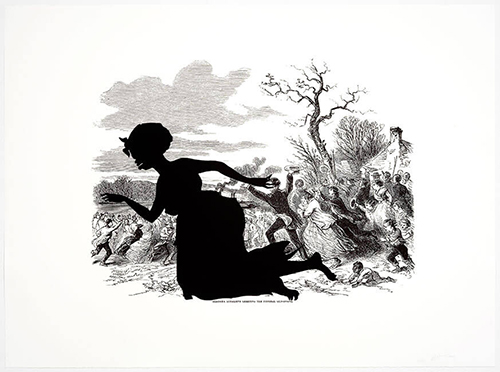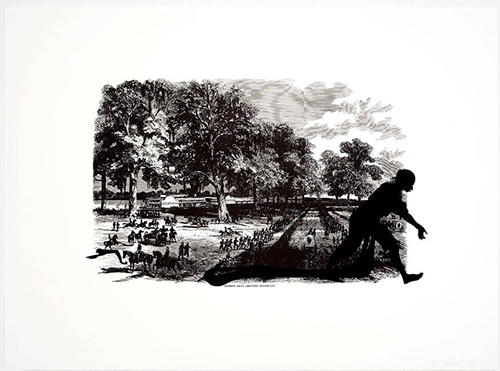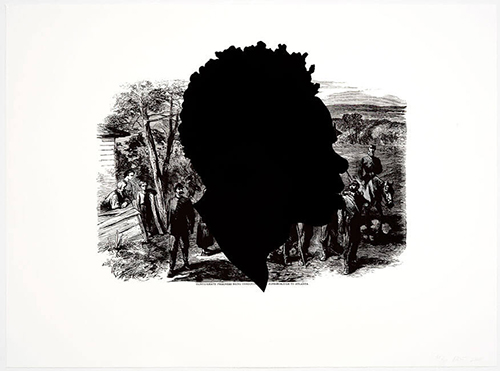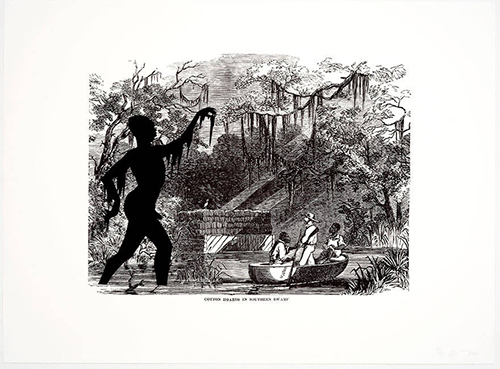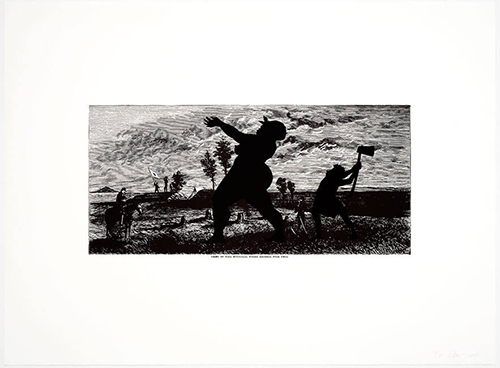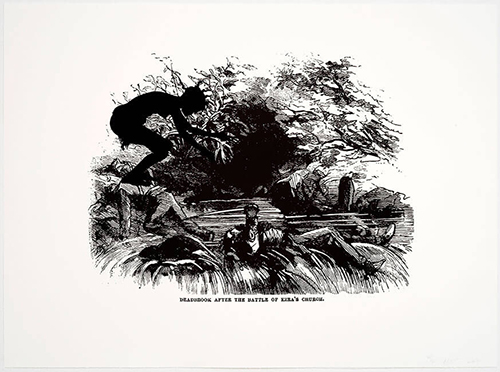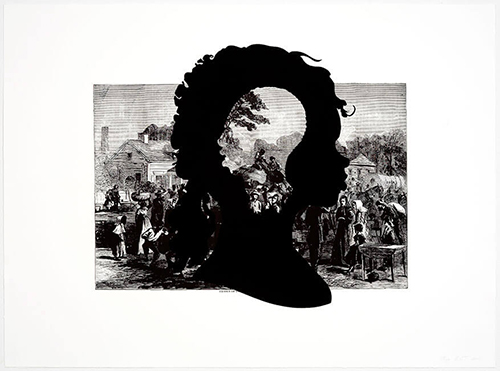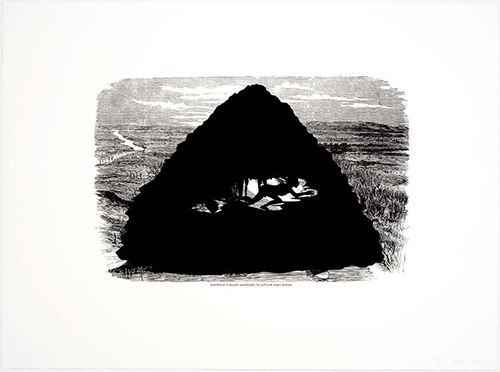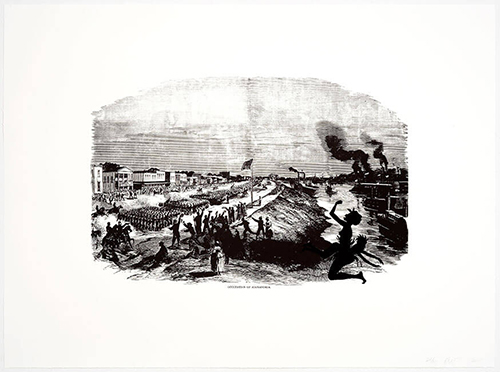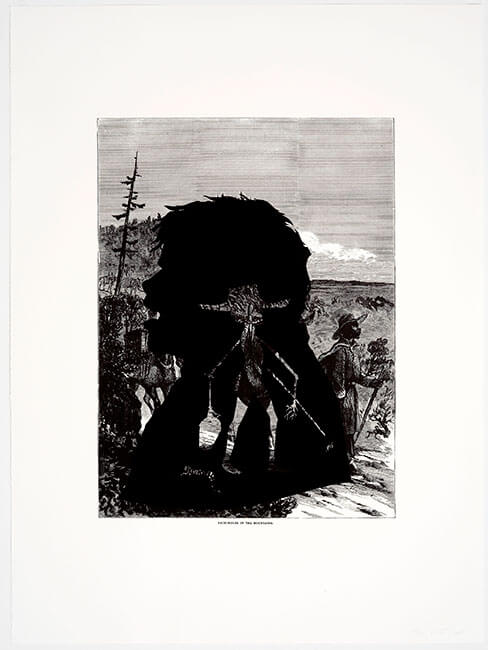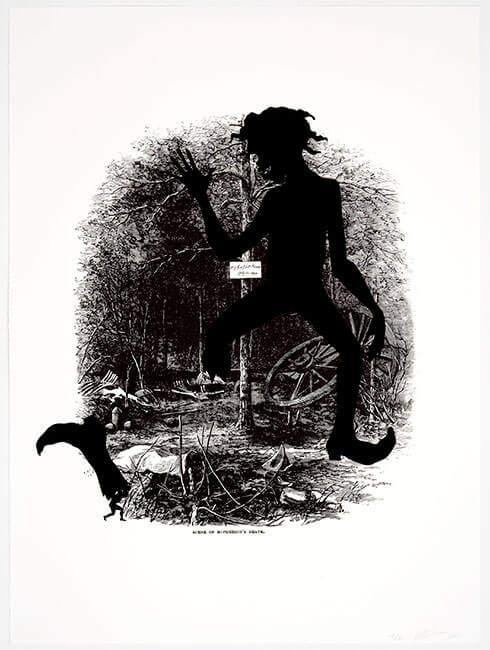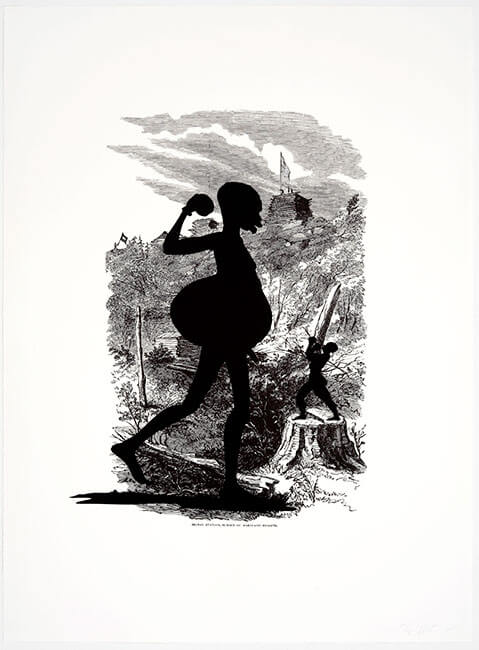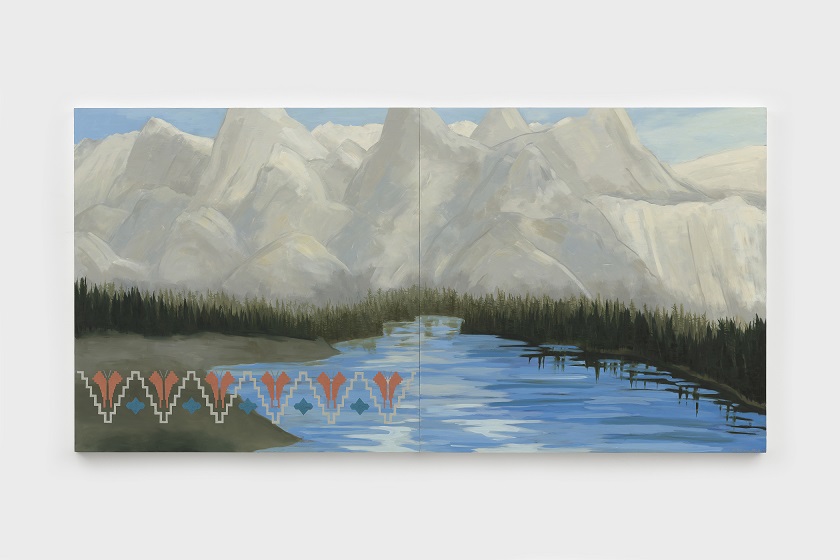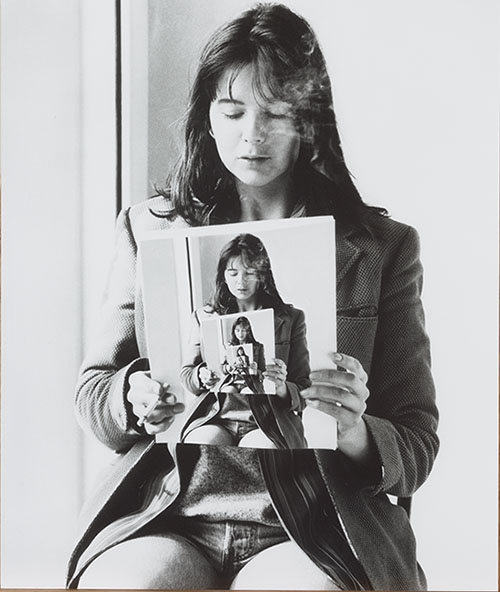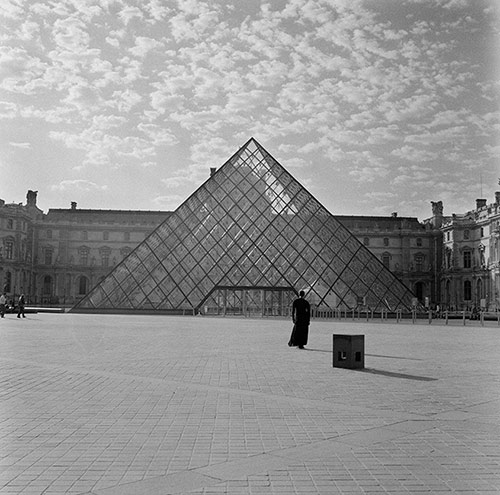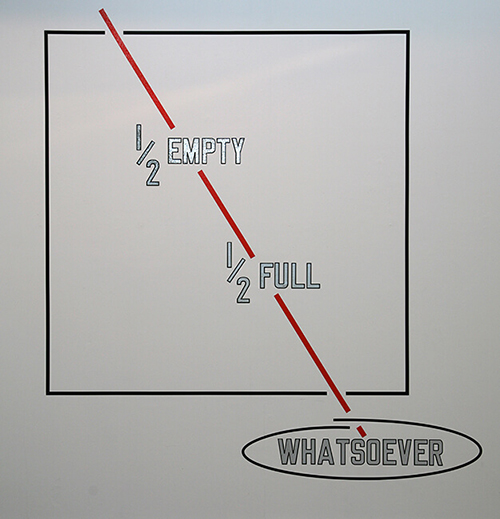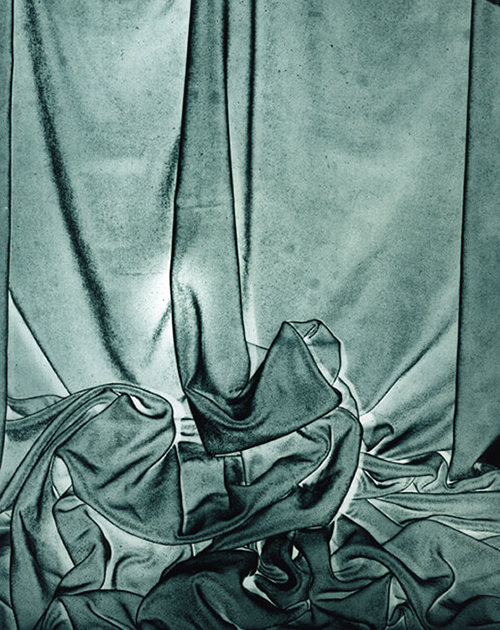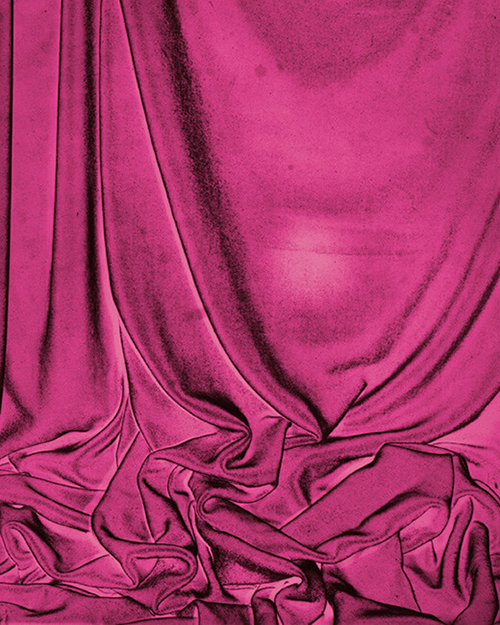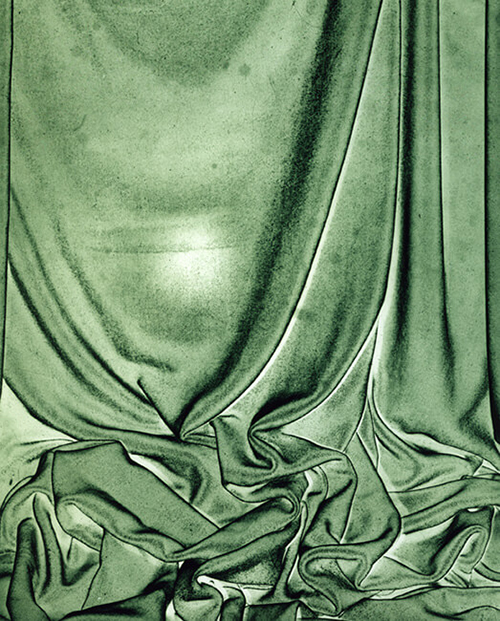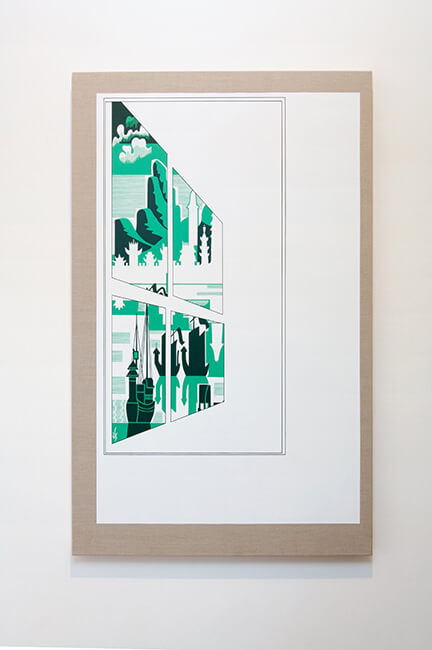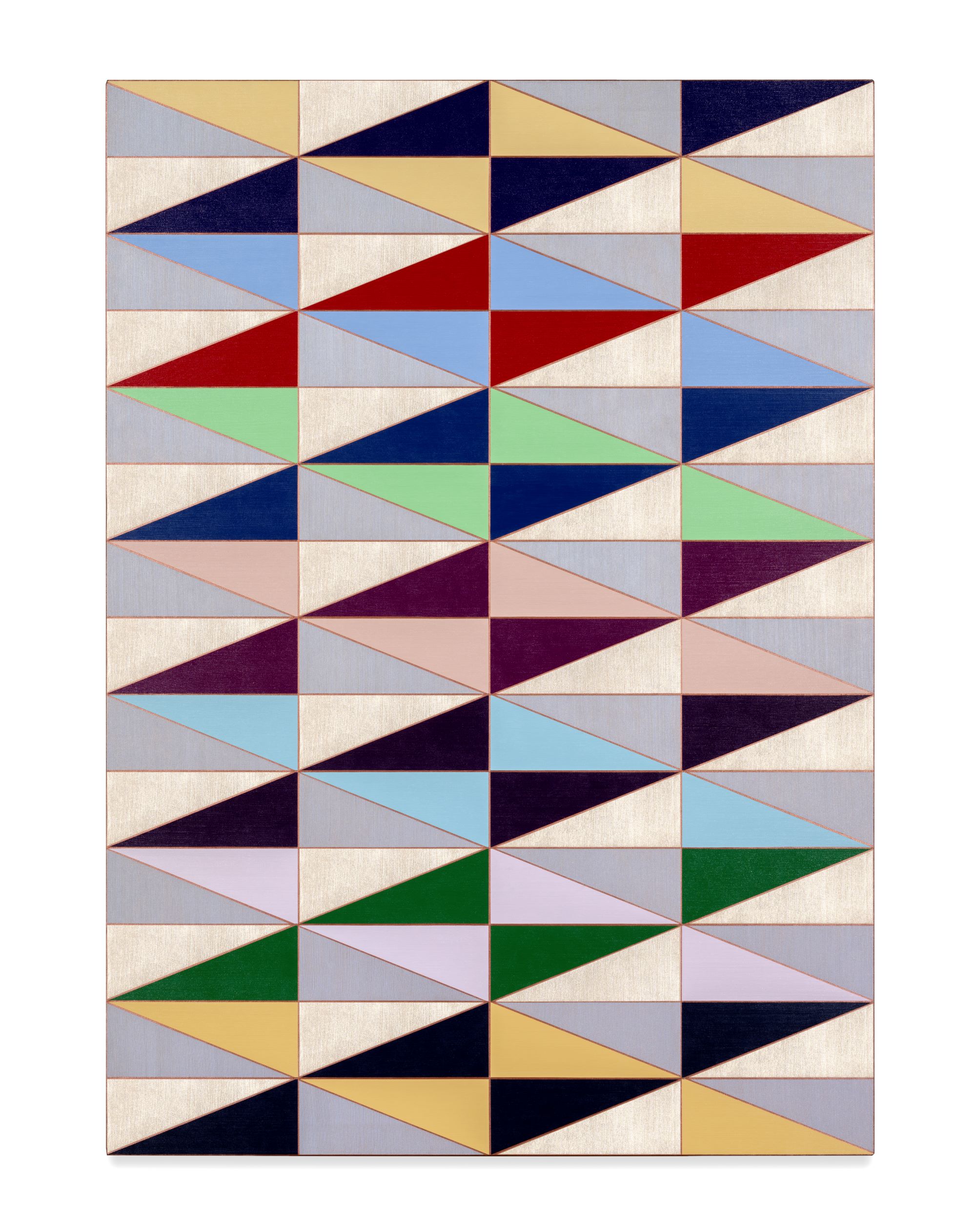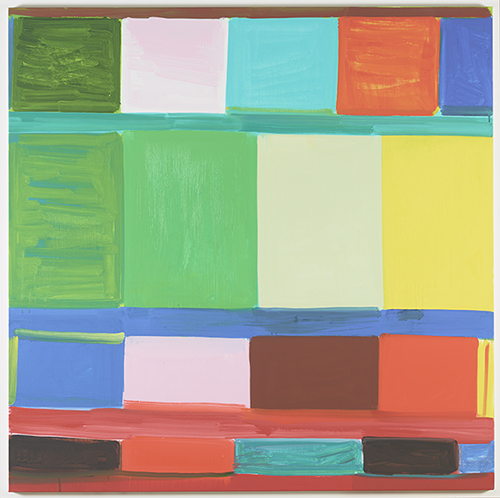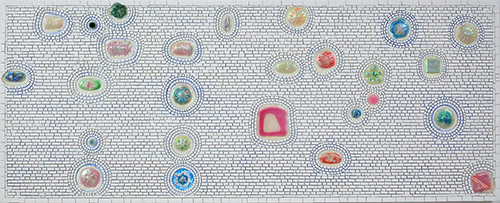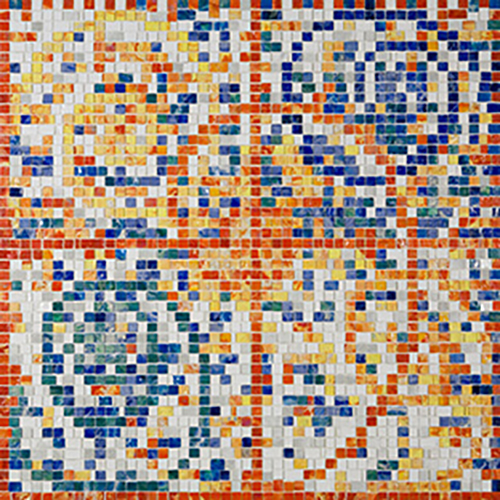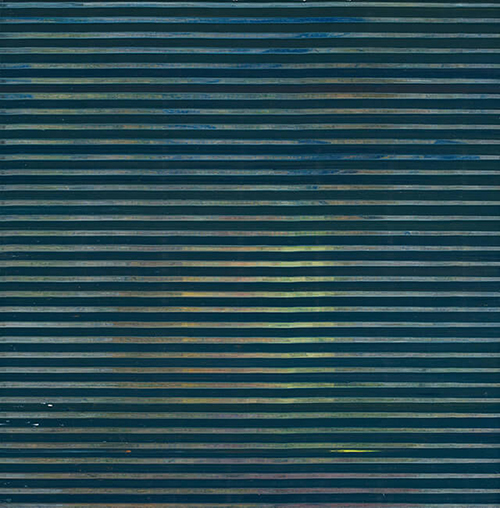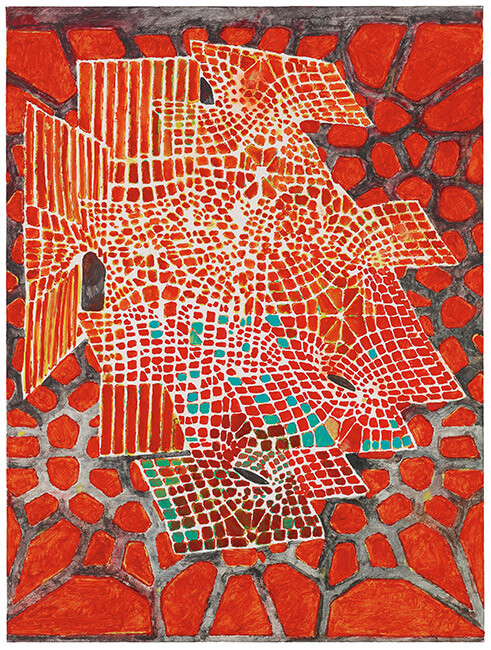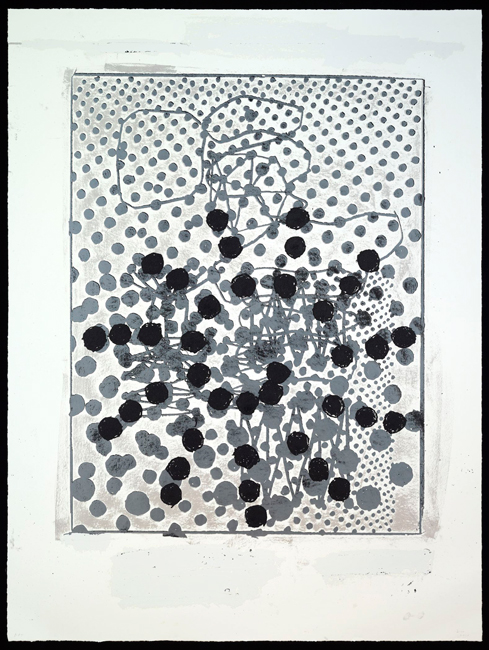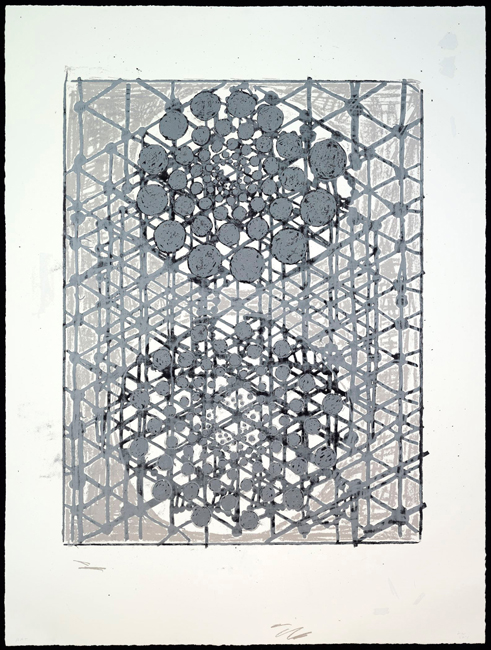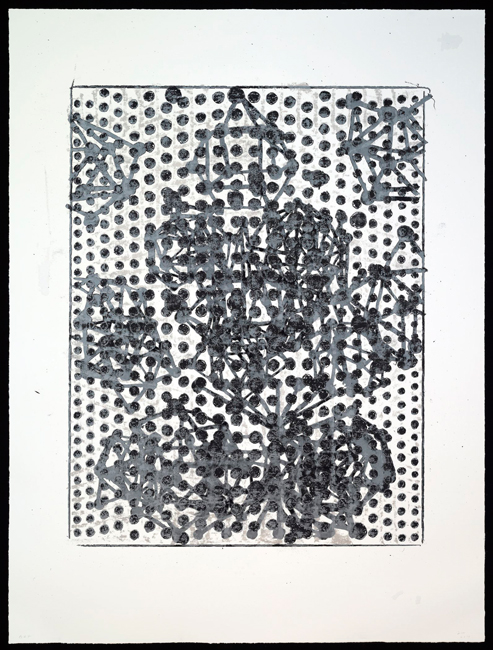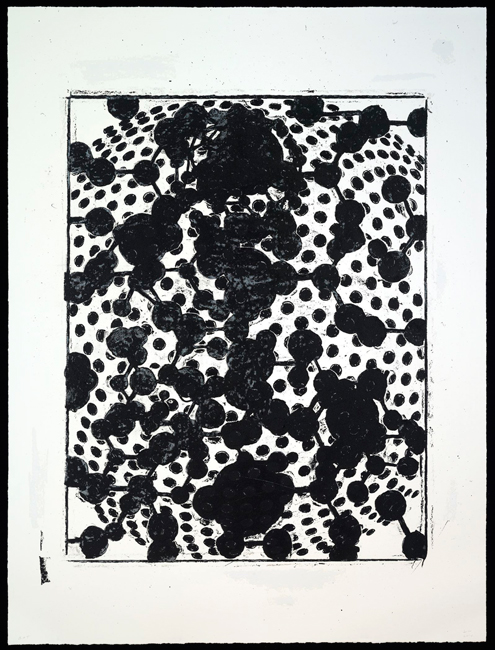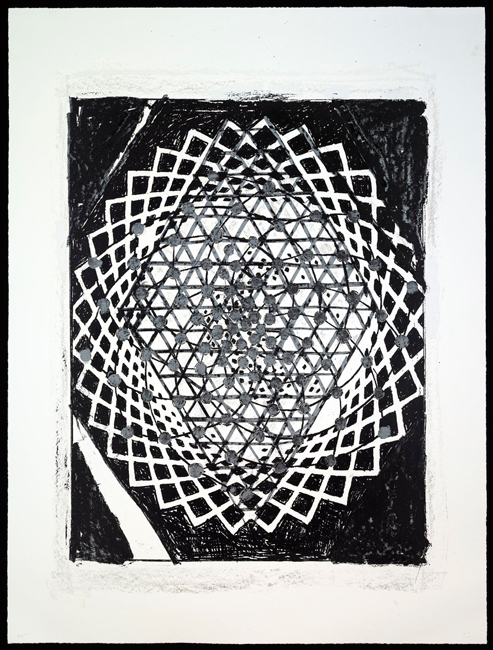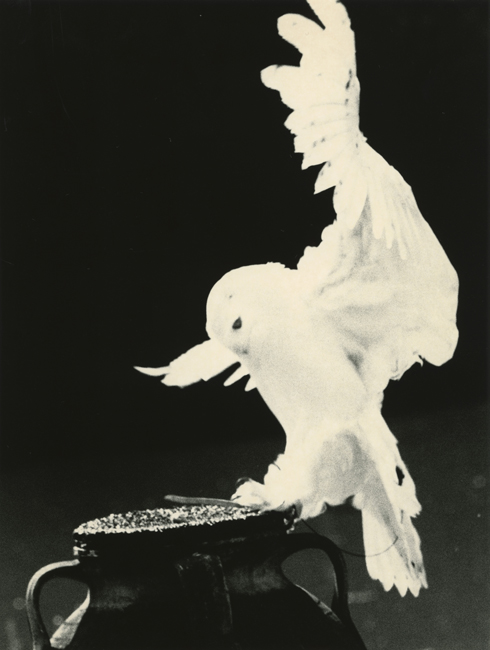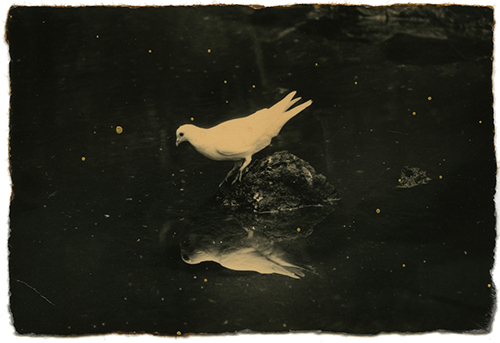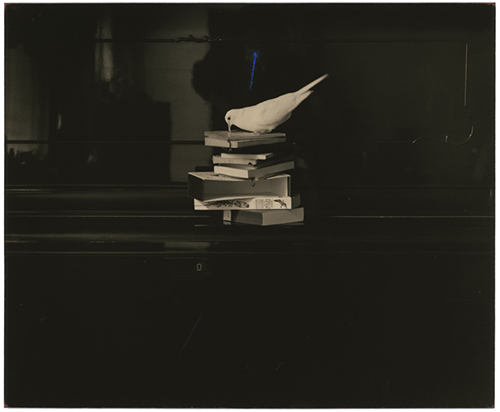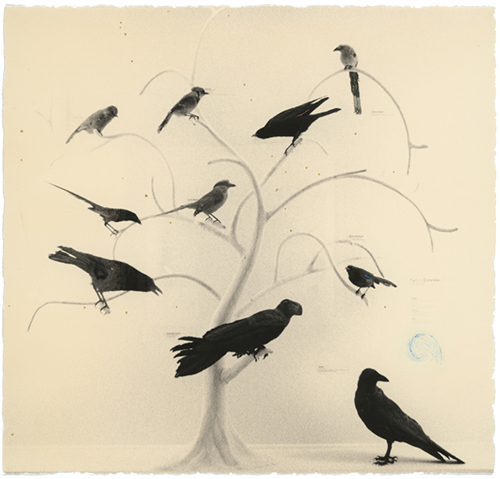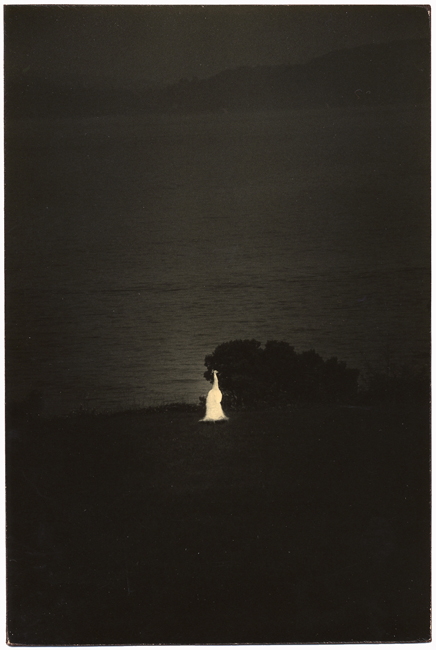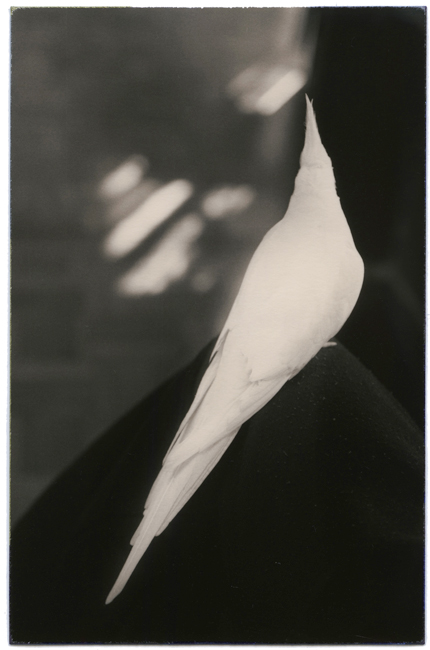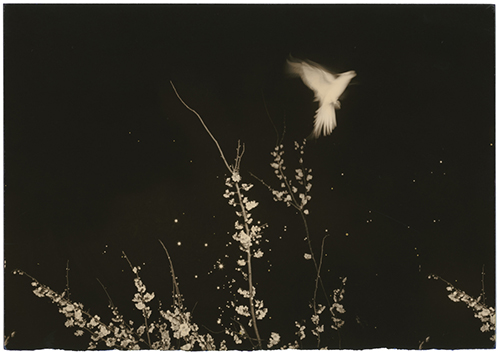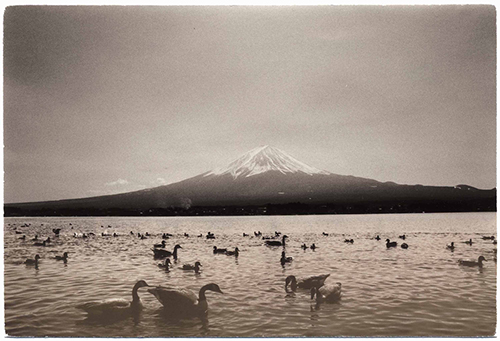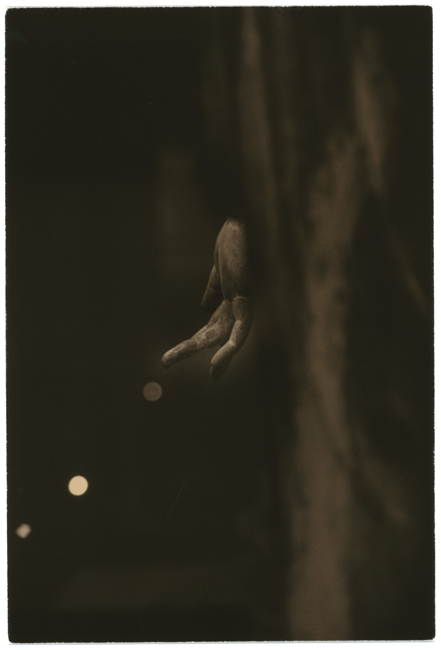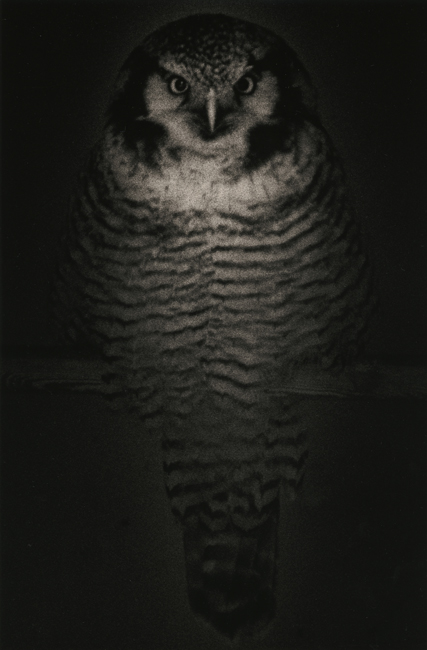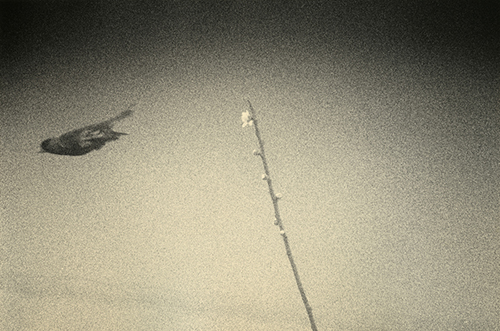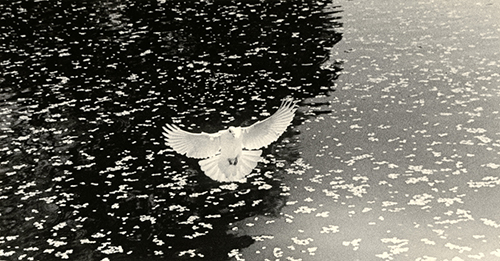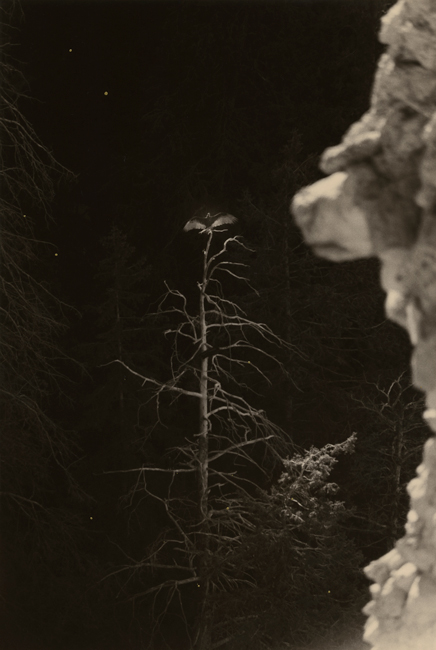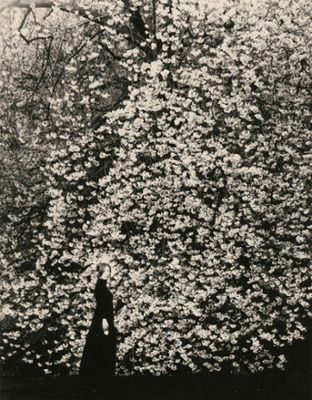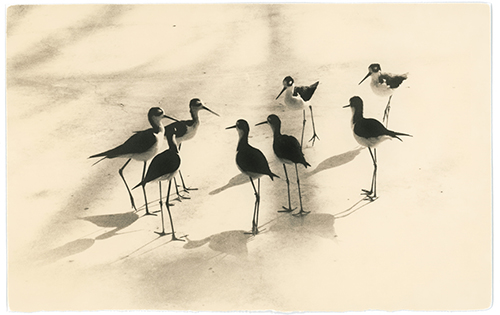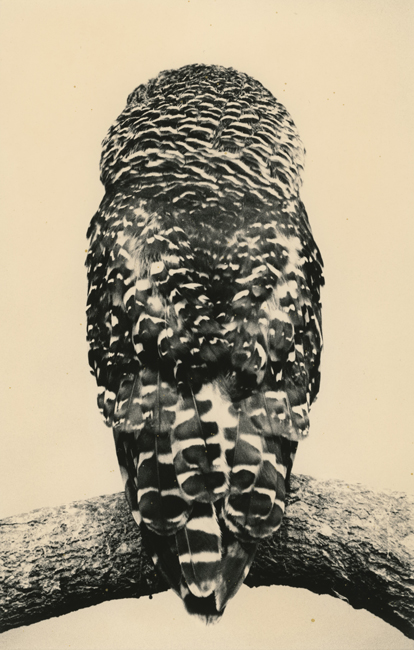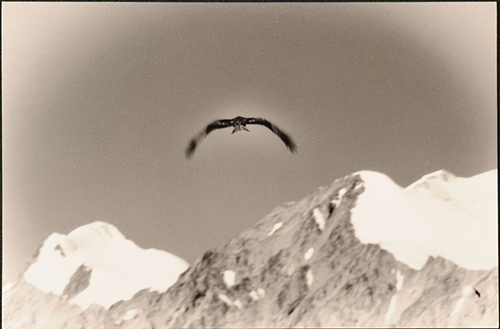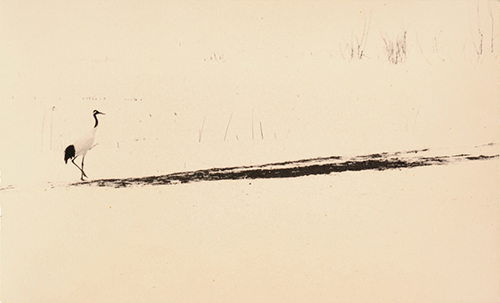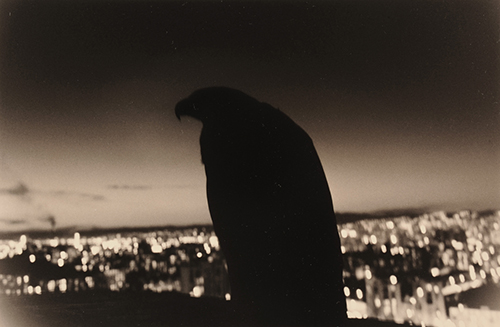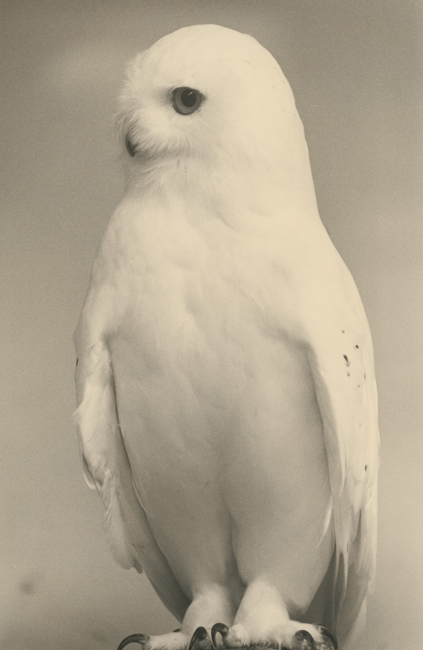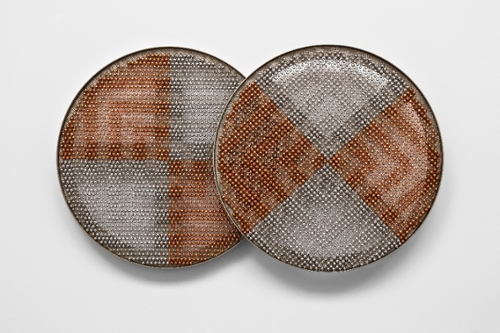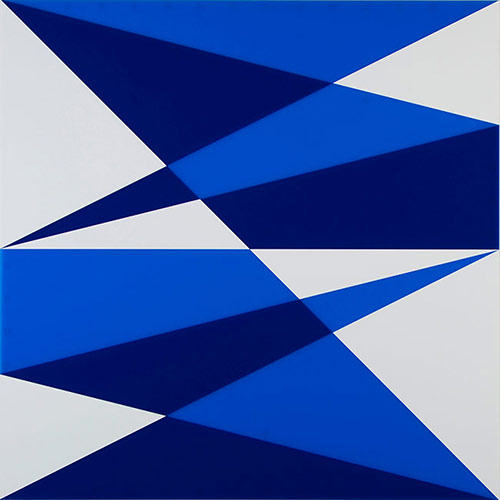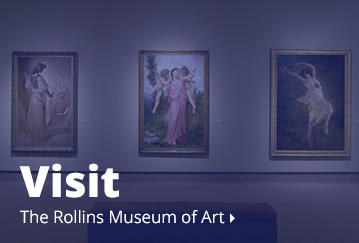Alfond Collection: Artists W-Z
From Kara Walker to Terry Winters, explore the works of artists W-Z in the Alfond Collection of Contemporary Art.
PLEASE NOTE: Not all works in the Rollins Museum collection are on view at any given time. View our Exhibitions page to see what's on view now. If you have questions about a specific work, please call 407-646-2526 prior to visiting.
Artists Featured in This Section
Kara Walker
(American, b. 1969)Alabama Loyalists Greeting the Federal Gun-Boats, from the portfolio Harper's Pictorial History of the Civil War (Annotated), 2005
Offset lithography and silkscreen
39 x 53 in.
The Alfond Collection of Contemporary Art, Gift of Barbara '68 and Theodore '68 Alfond, 2013.34.162. © Kara Walker
Kara Walker is an African American artist who investigates themes of racism and sexism through explicit imagery. She appropriates the styles, history, and art of the nineteenth-century American South to introduce social narratives that challenge dominant histories of the Civil War. In Walker’s graphic narratives, she considers the enduring legacy of racism through “the idea that a black subject in the present tense is a container for specific pathologies from the past and is continually growing and feeding off those maladies.”[1]
In the 1990s, Walker adopted the cut-paper silhouette, a popular nineteenth-century form of portraiture, as her signature technique. Using matte black paper, she carves a racially exaggerated cast of stereotyped characters exhumed from slavery—mammies, coons, and piccaninnies—engaged in violent and sexual acts. In these cut caricatures, Walker addresses Johann Kaspar Lavater’s pervasive theory of physiognomy that linked physical form to “moral character,” which perpetuated horrifically unfounded and malicious racial stereotypes at the time.
In her 2005 series Harper’s Pictorial History of the Civil War (Annotated), Walker appropriates and subverts illustrations of the Civil War—originally published in Harper’s Weekly—by silkscreening a range of her silhouetted caricatures over the lithographic prints. Although Harper’s articles claimed to “narrate events just as they occurred,”[2] they grossly over-emphasized the specifics of military maneuvers and campaigns, neglecting the social impact of war and marginalizing black slaves in their depictions. Walker reinserts these bodies in prints like Buzzard’s Roost Pass, where she overlays a dismembered young black woman onto a battle scene. With her severed head frozen in terror, her breast ripped from her body, and her shredded hand floating above the picture plane, the mutilated woman expresses the horrors of war and the barbarism of slavery, unrepresented in the original lithograph.
In the suite of prints, Walker’s characters weep, float, and defecate on Civil War battle scenes. These inflammatory interjections have spurred controversy, inspiring criticism that she perpetuates racism and sexism by reinforcing stereotypes and debasing women. In works like Harper’s Pictorial History of the Civil War (Annotated), Walker plays the provocateur, presenting the abject, taboo, traumatic, and politically incorrect to reconsider slavery’s enduring reverberations in our conceptions of race and identity today.
--Lexi Lee Sullivan
Kara Walker
(American, b. 1969)An Army Train, from the portfolio Harper's Pictorial History of the Civil War (Annotated), 2005
Offset lithography and silkscreen
39 x 53 in.
The Alfond Collection of Contemporary Art, Gift of Barbara '68 and Theodore '68 Alfond, 2013.34.168. © Kara Walker
Kara Walker
(American, b. 1969)Banks's Army Leaving Simmsport, from the portfolio Harper's Pictorial History of the Civil War (Annotated), 2005
Offset lithography and silkscreen
39 x 53 in.
The Alfond Collection of Contemporary Art, Gift of Barbara '68 and Theodore '68 Alfond, 2013.34.160. © Kara Walker
Kara Walker
(American, b. 1969)Buzzard's Roost Pass, from the portfolio Harper's Pictorial History of the Civil War (Annotated), 2005
39 x 53 in.
The Alfond Collection of Contemporary Art, Gift of Barbara '68 and Theodore '68 Alfond, 2013.34.155. © 2015 Kara Walker. © Kara Walker
Kara Walker
(American, b. 1969)Confederate Prisoners Being Conducted from Jonesborough to Atlanta, from the portfolio Harper's Pictorial History of the Civil War (Annotated), 2005
Offset lithography and silkscreen
39 x 53 in.
The Alfond Collection of Contemporary Art, Gift of Barbara '68 and Theodore '68 Alfond, 2013.34.159. © Kara Walker
Kara Walker
(American, b. 1969)Cotton Hoards in Southern Swamp, from the portfolio Harper's Pictorial History of the Civil War (Annotated), 2005
Offset lithography and silkscreen
39 x 53 in.
The Alfond Collection of Contemporary Art, Gift of Barbara '68 and Theodore '68 Alfond, 2013.34.158. © Kara Walker
Kara Walker
(American, b. 1969)Crest of Pine Mountain, where General Polk Fell, from the portfolio Harper's Pictorial History of the Civil War (Annotated), 2005
Offset lithography and silkscreen
39 x 53 in.
The Alfond Collection of Contemporary Art, Gift of Barbara '68 and Theodore '68 Alfond, 2013.34.161. © Kara Walker
Kara Walker
(American, b. 1969)Deadbrook after the Battle of Ezra's Church, from the portfolio Harper's Pictorial History of the Civil War (Annotated), 2005
Offset lithography and silkscreen
39 x 53 in.
The Alfond Collection of Contemporary Art, Gift of Barbara '68 and Theodore '68 Alfond, 2013.34.164. © Kara Walker
Kara Walker
(American, b. 1969)Exodus of Confederates from Atlanta, from the portfolio Harper's Pictorial History of the Civil War (Annotated), 2005
Offset lithography and silkscreen
39 x 53 in.
The Alfond Collection of Contemporary Art, Gift of Barbara '68 and Theodore '68 Alfond, 2013.34.156. © Kara Walker
Kara Walker
(American, b. 1969)Foote's Gun-Boats Ascending to Attack Fort Henry, from the portfolio Harper's Pictorial History of the Civil War (Annotated), 2005
Offset lithography and silkscreen
39 x 53 in.
The Alfond Collection of Contemporary Art, Gift of Barbara '68 and Theodore '68 Alfond, 2013.34.165. © Kara Walker
Kara Walker
(American, b. 1969)Lost Mountain at Sunrise, from the portfolio Harper's Pictorial History of the Civil War (Annotated), 2005
Offset lithography and silkscreen
39 x 53 in.
The Alfond Collection of Contemporary Art, Gift of Barbara '68 and Theodore '68 Alfond, 2013.34.166. © Kara Walker
Kara Walker
(American, b. 1969)Occupation of Alexandria, from the portfolio Harper's Pictorial History of the Civil War (Annotated), 2005
Offset lithography and silkscreen
39 x 53 in.
The Alfond Collection of Contemporary Art, Gift of Barbara '68 and Theodore '68 Alfond, 2013.34.157. © Kara Walker
Kara Walker
(American, b. 1969)Pack-Mules in the Mountains, from the portfolio Harper's Pictorial History of the Civil War (Annotated), 2005
Offset lithography and silkscreen
39 x 53 in.
The Alfond Collection of Contemporary Art, Gift of Barbara '68 and Theodore '68 Alfond, 2013.34.163. © Kara Walker
Kara Walker
(American, b. 1969)Scene of McPherson's Death, from the portfolio Harper's Pictorial History of the Civil War (Annotated), 2005
Offset lithography and silkscreen
39 x 53 in.
The Alfond Collection of Contemporary Art, Gift of Barbara '68 and Theodore '68 Alfond, 2013.34.154. © Kara Walker
Cut-paper silhouettes make up an important part of Kara Walker’s work. As a form of portraiture, silhouettes were relatively inexpensive in comparison to oil paintings and became increasingly popular during the nineteenth century. Often made in large-scale, Walker’s silhouettes are applied directly to walls. In the 15 prints in the Museum’s permanent collection these iconic silhouettes, still presented in grand scale in comparison with the rest of the composition, are overlaid on illustrations from Harper’s Weekly, a pro-Union publication that rarely focused on African American life during the war. This print portfolio marks the first time the artist worked directly with source material from the American Civil War era, disturbing the archive. The background image represented in Scene of McPherson’s Death from Harper’s Pictorial History of the Civil War (Annotated) originally appeared in Harper’s Weekly with a lengthy caption.
The original illustration demonstrates the loss of life and general chaos at the scene of the General’s death. Walker’s superimposed silhouette form also experiences horrific violence, as evidenced by mangled and distorted limbs. These types of fantastical, carnivalesque moments are also typical of the artist’s work. The silhouette compositions combine diverse influences from American history, cyclorama painting, systemic racism, stereotypes, and the grotesque. Walker intervenes in the historical past with these silhouette forms, questioning the way histories are constructed.
Kara Walker
(American, b. 1969)Signal Station, Summit of Maryland Heights, from the portfolio Harper's Pictorial History of the Civil War (Annotated), 2005
Offset lithography and silkscreen
39 x 53 in.
The Alfond Collection of Contemporary Art, Gift of Barbara '68 and Theodore '68 Alfond, 2013.34.167. © Kara Walker
Kay WalkingStick
(Native American, b. 1935)Long Valley Caldera, 2013
Oil on panel
40 x 80 x 2 in.
The Alfond Collection of Contemporary Art, Rollins Museum of Art, Gift of Barbara '68 and Theodore '68 Alfond. 2022.2.2. Image courtesy the artist and Hales, London and New York. Photo by JSP Art Photography
A member of the Cherokee Nation, Kay WalkingStick is a contemporary artist who combines representational and graphic elements to explore identity by connecting the present with the historical past. In her long career, WalkingStick has addressed multiple themes in her work including feminism, nature, and Native history, among others. However, the American landscape has been a constant source of inspiration and the axis of her artistic inquiry. Her approach connects the experience of the physical world with its spiritual dimension, resulting in the creation of paintings that expound the metaphorical meaning of the landscape in the context of American history. In this painting, the artist depicts the overwhelming vastness of the Long Valley Caldera, emphasizing its sublime serenity and sacred like status. Native American pattern designs on the left panel affirm the presence of Native peoples and act as a reminder of their existence and connection with place. WalkingStick is a Professor Emerita at Cornell University and currently lives and works in Pennsylvania.
Gillian Wearing
(British, b. 1963)Me:Me, 1991-92
Bromide print mounted on aluminum
20 1/4 x 17 1/8 in.
The Alfond Collection of Contemporary Art, Gift of Barbara '68 and Theodore '68 Alfond, 2016.3.16. Image courtesy of the artist, Tanya Bonakdar Gallery, New York and Maureen Paley, London.
Carrie Mae Weems
(American, b. 1963)Louvre, 2006
Digital c-print
73 x 61 in.
The Alfond Collection of Contemporary Art, Gift of Barbara '68 and Theodore '68 Alfond, 2014.1.24. © Carrie Mae Weems. Image courtesy of the artist and Jack Shainman Gallery, New York.
Carrie Mae Weems
(American, b. 1963)Untitled (Woman with Daughter), From the Kitchen Table Series, 1990
Silver prints, triptych
28 1/4 x 28 1/4 inches each
The Alfond Collection of Contemporary Art, Gift of Barbara '68 and Theodore '68 Alfond, 2014.1.26. © Carrie Mae Weems. Image courtesy of the artist and Jack Shaiman Gallery, New York.
American photographer Carrie Mae Weems combines social documentary, self-portraiture, and performance to construct complex narratives that confront historical representations of black Americans. Frequently using her own body, Weems enacts racialized types adapted from archival images and restages photographs to expose the complex role images play in perpetuating racial discrimination.
Weems’s Kitchen Table Series, one of her most iconic works, comprises twenty black-and-white photographs and fourteen text panels. The series—performed by Weems—focuses on one woman, her self-reflection, and her interactions with family and friends. Weems’s character represents “everywoman,” but also implicitly exposes social and cultural assumptions about black womanhood. Each scene is posed around an archetypal kitchen table, like a stage set. In the outtake Untitled (Woman with Daughter), the woman and her adolescent daughter perform three scenarios that reveal their complex relationship. Each meticulously staged scene includes the same components—protagonists, props, and place—yet in each frame Weems alters body language and position to drastically change the tone. Through subtle gestures, Weems communicates the range of maternal and familial exchange: curiosity, mutual respect, frustration, neglect, and companionship.
While Weems presents a set and characters, she also cleverly reveals the viewer’s own assumptions by providing only minimal information. Depending on the viewer’s life experiences, these scenes could be read in a number of ways. Perhaps this is a single-parent home where the mother is struggling to raise her daughter, or maybe these are glimpses into typical evening homework rituals. In these three images as well as the full Kitchen Table Series, what is clear is the intensity of the mother’s effort to maintain or break from her perceived identity. Weems reveals persistent tropes and asks her viewers, regardless of race or gender, to question their own presuppositions.
In her ongoing Museum Series, Weems performs a series of more conceptual and layered narratives that move beyond racial identity into the realm of inequality of access and inclusion. In each photograph Weems stands, with her back turned to the camera, in proximity to one of the world’s leading museums and cultural institutions. In Louvre, she appears in front of I. M. Pei’s iconic pyramid clad entirely in black. Her quiet contemplation is an act of protest and witness to years of discriminatory collecting and exhibiting practices. As a woman of color and an artist, she creates a performance at each site that evokes years of exclusion, reminding us of the distance we have yet to cover on the road to equality.
--Anna Stothart
Lawrence Weiner
(American, b. 1940)1/2 EMPTY 1/2 FULL WHATSOEVER CAT. #991, 2008
Language + the materials referred to
Installation
The Alfond Collection of Contemporary Art, Gift of Barbara '68 and Theodore '68 Alfond, 2013.34.120. © Lawrence Weiner / Artists Rights Society (ARS), New York.
Lawrence Weiner, a foundational figure in the emergence of Conceptual art in the 1960s, primarily uses words and typography as his “medium” to convey ideas. In his influential small book Statements (1968), which includes descriptions of artworks realized and unrealized, Weiner writes, “(a) the artist may construct the piece; (b) the piece may be fabricated; (c) the piece may not be produced at all.” What is important for Weiner is the concept communicated through language, and this can be received, interpreted, and made material in any number of ways. Weiner’s artworks take various forms; sculptures, paintings, photographs, books, performances, and—most often—large-scale typographic wall installations. In each case, he employs forms that operate reciprocally with his words or phrases to set ideas into motion. His works perform on multiple levels—spatial, visual, poetic, and political—to communicate complex and open-ended ideas.
1/2 EMPTY 1/2 FULL WHATSOEVER is part of a series made by Weiner in 2008 and 2009 that repeats a consistent visual format to engage a philosophical idea and its process.[1] Each work consists of a black square cut diagonally by a red line that connects three sets of words or phrases. The first two, placed inside the square, convey opposites—full and empty, begun and finished, thrown in front of the front and pushed to the beginning of the end. The third is a conjunctive adjective—whatsoever, whensoever, howsoever—that connects the first two words or phrases and qualifies their relationship. By circling these conjunctive adjectives and placing them just outside the square at the end of the red line, Weiner treats them visually as outcomes of the action captured within the square field. The text “1/2 EMPTY 1/2 FULL” alludes to the common expression “Is the glass half full or half empty?” which usually refers to one’s perception of a situation as either optimistic or pessimistic. “WHATSOEVER” seems to undercut the proposed distinction between half full and half empty, implying that the same outcome will result, regardless of a person’s point of view. It is perhaps a realist’s response to the false divisions that make up many moral categories. The artwork, a kind of philosophical diagram, remains intentionally open so that viewers can interpret the “whatsoever” that adjoins two opposed viewpoints for themselves.
--Ruth Erickson
[1] These works were made for the exhibition 1/2 EMPTY 1/2 FULL (January 31-March 7, 2009) at Yvon Lambert Gallery in Paris.
James Welling
(American, b. 1951)Alcott, 2006
C-print, ed. 3 of 5
31 1/5 x 25 in.
The Alfond Collection of Contemporary Art, Rollins Museum of Art. Gift of Barbara '68 and Theodore '68 Alfond, 2013.34.27. © James Welling. Image courtesy of the artist and David Zwirner, New York/London.
Since the 1970s, photographer James Welling has questioned the limitations of his medium. Using colored filters and shifts in focus, and wedding conceptual rigor with sentimentality, his depopulated images document an abstract, invisible concept: memory.
Welling finds the norms of photography problematic. Instead of replicating and recounting the facts of the visible world, he searches for meaning in ambiguity. One of his earliest series depicted a family dairy and Connecticut farm. Despite the fact that these photographs document real places, they lack identifying specifics. A sense of nostalgia and history are palpable, and a romance with the landscape comes through; those sensations are the true subjects of those prints.
As an art student at California Institute of the Arts, Welling studied with John Baldessari, a founder of American Conceptualism. Baldessari’s photographic works are direct—sequential images with text that further explain (or confound) what is happening in the presented image. Welling reacted against this lack of emotion. But while he imbues his own work with visual poetry, his photographs are not merely aesthetic, they are perceptual exercises. Through the use of filters he presents his subjects in unexpected and thought-provoking ways. They are as much about how viewers see as what they see.
In 2005, Welling began making multiple exposures using six-colored filters, which he dubbed “Hexachromes.” This practice inspired new ways of shooting, which he applied to a series of photographs of architect Philip Johnson’s Glass House. The cascading colored light that envelops the familiar landmark is like an apparition. It pushes the glass house out of our times and into an indeterminate past while also conjuring the complex and mysterious science of sight.
The complete set of photographs is Welling’s Author series are named for nine 19th-centruy writers. They look backward not only in their titling, but because they revisit a subject he has photographed before: drapery. In fact, Welling reused the actual negatives he had shot years before of drapery. The Authors series simultaneously depicts a recognizable form and an abstraction; pairing a subject explored throughout art history—beautifully depicted by the ancient Greeks, Leonardo Da Vinci, and others—with the bright colors attainable only with contemporary printing methods. These works encapsulate the dualistic nature of Welling’s practice, which seeks to illustrate that the camera can serve more than one role.
--Al Miner
James Welling
(American, b. 1951)Emerson, 2007
C-print, ed. 4 of 5
31 1/5 x 25 in.
The Alfond Collection of Contemporary Art, Gift of Barbara '68 and Theodore '68 Alfond, 2013.34.29. © James Welling. Image courtesy of the artist and David Zwirner, New York/London.
James Welling
(American, b. 1951)Thoreau, 2006
C-print, ed. 3 of 5
31 1/5 x 25 in.
The Alfond Collection of Contemporary Art, Gift of Barbara '68 and Theodore '68 Alfond, 2013.34.28. © James Welling. Image courtesy of the artist and David Zwirner, New York/London.
Pae White
(American, b. 1963)Green Grotto, 2006
Acrylic on canvas
63 63/64 x 40 5/32 in.
The Alfond Collection of Contemporary Art, Gift of Barbara '68 and Theodore '68 Alfond, 2014.1.18. Image courtesy of the artist and 1301PE, Los Angeles.
The analogy between paintings and windows is common: both are two-dimensional surfaces that grant visual access to distant vistas. In Green Grotto (2006), Pae White literalizes this metaphor with a trompe-l’oeil window frame that opens out into the imaginary space beyond the canvas. The four windowpanes offer a glimpse of a fairy-tale landscape with romantic cliffs, noble castles, and proud ships sailing out to sea. The dreamy mood is enhanced by the lush, monochromatic emerald color scheme; this could easily be Eden or Oz. And yet, as the window swings open, it carries the image with it, leaving only an empty white rectangle in its wake. Furthermore, this blank space is surrounded by a border of unprimed, unpainted brown canvas on all sides. This framing device breaks the spell cast by Green Grotto, reminding the viewer that the scene is, after all, only paint on canvas. The artist thus teases and tempts the viewer with multiple levels of fantasy and reality.
Though Green Grotto illuminates the possibilities and limitations of traditional painting media, much of White’s art utilizes unorthodox and ephemeral materials. Since 2006, she has woven photorealistic tapestries depicting reflective folds of aluminum foil or evanescent curls of white smoke. In these works, White skillfully uses soft polyester to portray materials with completely different properties, such as crisp metal or intangible vapor. In so doing, she creates surprising yet convincing material illusions. Often, White installs monumental textiles to create immersive environments. The artist has pushed her exploration of decorative craft media further into three dimensions by designing murals out of neon tubes, dangling prisms of glass and paper from clear monofilament strands, and stringing colored thread through white galleries to create laser-like optical effects. Not unlike Green Grotto, these installations propose whimsical yet radical new spatial possibilities.
--Sarah Parrish
Dyani White Hawk
(Native American, b. 1976)Wowačhi I Dancing, 2023
acrylic on canvas
84 x 60 x 2 3/8 in.
The Alfond Collection of Contemporary Art, Rollins Museum of Art. Gift of Barbara '68 and Theodore '68 Alfond, 2024.1.2 Courtesy of the artist and Various Small Fires, Los Angeles / Dallas / Seoul. Photo Credit: Rik Sferra
Dyani White Hawk fuses modern abstract painting with Lakota art forms. With Sičangu Lakota and European American ancestry, and growing up in both communities, White Hawk’s art reflects on her cross-cultural experiences to better understand “the intricacies of self and culture, correlations between personal and national history, and Indigenous and mainstream art histories.”
This work is part of her 2023-2024 series Reflection, a grouping of paintings, mixed-media works, and a video installation. This series explores aesthetic abstraction that, while popularized by European and American artists, has deep roots in art practiced by Indigenous American artists. White Hawk also acknowledges the role of Indigenous women in upholding historic art forms, from painting to beadwork. Within the work Wowačhi | Dancing, White Hawk plays with light and dark colors that are caught in a visual dance, interacting with one another in a way that drives the composition toward balance, possibly representing the reconciliation between her own identities.
Stanley Whitney
(American, b. 1946)The Days of My Years, 2016
Oil on Linen
72.05 x 72.05 in.
The Alfond Collection of Contemporary Art, Gift of Barbara '68 and Theodore '68 Alfond, 2016.3.4. © Stanley Whitney
Jack Whitten
(American, 1939-2018)Blue Shift, 2010
Acrylic collage on canvas
32 1/2 x 80 1/4 in.
The Alfond Collection of Contemporary Art, Gift of Barbara '68 and Theodore '68 Alfond, 2013.34.4. © Jack Whitten Estate. Image courtesy the Jack Whitten Estate and Hauser & Wirth
Since the 1960s, Jack Whitten has explored unconventional and inventive methods of applying paint to canvas. Arriving in New York in the wake of Abstract Expressionism, he was among a group of artists working to assert their independence by utilizing alternative modes of expression through varied visual experiments in abstraction. While a number of his peers were drawn to popular movements in art such as post-painterly abstraction, Minimalism, and Pop art, Whitten developed his own vernacular by treating paint as a sculptural material—something that could be assembled, carved, cut, and chiseled.
Often incorporating dyes, powders, and various organic and inorganic materials into acrylic paint, Whitten’s technique is to pour the paint mixture into flat pans, allowing it to dry. He then cuts, tears, and otherwise “deconstructs” the material into small chips resembling tesserae (mosaic tiles) that, when assembled, become the surface of his paintings. Though the canvases are still covered with paint, Whitten’s experimentation with the medium and its application transcends its materiality.
Memorial paintings are integral to Whitten’s practice. Each one is a commemoration of a family member, friend, or individual whose creativity and character inspired him. “When I dedicate paintings it is my way of acknowledging that certain people existed as a spirit and energy. I take material and present it in a way to say that these spirits are still here. These people existed. I spoke to them. I knew them.”[1] In each case, the content of the work invokes the unique character and achievements of the person memorialized.
--Anna Stothart
[1] Jack Whitten quoted in Stuart Horodner, Jack Whitten: Memorial Paintings, exh. cat. (Atlanta: Atlanta Contemporary Art Center, 2008) 18.
Jack Whitten
(American, 1939-2018)E-Stamp IV (Five Spirals: For Al Loving), 2007
Acrylic on canvas
48 x 48 in.
The Alfond Collection of Contemporary Art, Gift of Barbara '68 and Theodore '68 Alfond, 2013.34.3. © Jack Whitten Estate. Image courtesy the Jack Whitten Estate and Hauser & Wirth
E-Stamp IV (Five Spirals: For Al Loving) (2007) pays homage to Al Loving (1935-2005), a prominent African American artist known for his abstract paintings and collages that explored vibrant juxtapositions of color, space, line, and form. Here, uniformly sized paint tiles of blue, green, yellow, orange, and white are organized on the surface of the canvas, creating a series of broken and pixelated grids and spirals merging Loving’s signature vocabulary and the generic format of an e-stamp—digital postage that can be downloaded and printed directly from the internet. For Whitten, the e-stamp provides a ready-made structural device that guides the general organization of the composition while also recalling the American tradition of memorialization through a commemorative postage stamp.
--Anna Stothart
A later painting, which is in the Alfond Collection of Contemporary Art, E-Stamp IV (Five Spirals: For Al Loving) (2007), pays tribute to the eponymous African American abstract artist. Resembling a tiled mosaic, this work exemplifies Whitten’s increasingly sculptural approach to the painted surface. Over nearly half a century of painting and through highly personal arrangements of color, texture, and line, Jack Whitten has reveled in the poignancy and power of paint.
--Sarah Parrish
Jack Whitten
(American, 1939-2018)Untitled II, 1974-75
Acrylic on canvas
41 51/64 x 41 51/64 in.
The Alfond Collection of Contemporary Art, Gift of Barbara '68 and Theodore '68 Alfond, 2014.1.19. © Jack Whitten Estate. Image courtesy the Jack Whitten Estate and Hauser & Wirth
For over fifty years, Jack Whitten has explored the material and metaphoric potential of acrylic paint. His early gestural style evolved out of American abstract expressionism in the 1960s. However, by the early 1970s he had literally pushed gesture to the background of his work, locking his swirling mists of color behind horizontal or vertical stripes. Whitten applied these linear elements using a variety of experimental tools, ranging from rakes, sponges, squeegees, and Afro combs to unique implements of his own invention.
Untitled II (1974–75) dates to this early phase of experimentation. In this painting, atmospheric clouds of color hover behind horizontal bands of dark teal. Cool blue shadows and smoldering yellow-orange embers flicker between the lines, which are themselves flecked with orange, yellow, and white. This sensitive orchestration of hue, value, and form generates sophisticated optical effects, typical of the artist’s formalist approach. However, it would be a mistake to interpret Whitten’s work in exclusively formalist terms, as many of his paintings indirectly communicate meaningful messages about contemporary sociopolitical concerns. For example, his abstractions have been inspired by influences as diverse as the civil rights movement, the Vietnam War, and 9/11.
In eschewing a descriptive title, Whitten allows for multiple interpretations in Untitled II. Yet as an African American, he has been particularly invested in countering racism and celebrating African American culture. Unlike his contemporaries, who directly illustrated these issues with representational images, Whitten preferred to work through these themes indirectly. Accordingly, Whitten dedicated abstract portraits to important African Americans including Martin Luther King, Romare Bearden, Duke Ellington, James Baldwin, and members of his own family.
--Sarah Parrish
Terry Winters
(American, b. 1949)Red Ground, 2013
Oil on linen
80 x 60 in.
The Alfond Collection of Contemporary Art, Rollins Museum of Art. Gift of Barbara '68 and Theodore '68 Alfond, 2014.1.41. © Terry Winters. Image courtesy the artist and Matthew Marks Gallery.
When Terry Winters began painting in the late 1960s, the medium was in decline. Against the gestalt forms of minimalist sculpture, it was not clear if painting could hold up. Yet Winters managed to incorporate the spatiality of sculpture into his painterly practice in ways that exceeded what was possible in three dimensions. Four decades later, he continues to create innovative work using simple formal devices. With Red Ground
(2013), he offers a labyrinthine network of intersecting planes, some projecting out of the canvas, others receding into its depths. Vertical and horizontal grids of red and white meet, contort, and torque, punctuated at moments by vibrant, contrasting turquoise. Their encounter is set against a pebbled red backdrop, evoking the solidity and grounding of cobblestones. He juxtaposes dynamism and stability, catching the viewer in a push-pull between surface and depth.
Both heavily theoretical (he finds affinity in French philosopher Gilles Deleuze) and immanently material, Winters’s paintings explore complex issues in visceral ways. His goal is to create what Wallace Stevens termed a “necessary fiction,” constructing a space that, even in its unreality, holds together as a deliberate entity through formal rigor. Despite his abstract vocabulary, he remains tied to representation, finding forms in the natural sciences, architecture, information systems, and computer graphics, and then developing them through painterly means. The resulting paintings stand as accounts of his explorations, documenting both the time of the painting and the artist’s decision-making process.
In Red Ground, Winters works through a kind of mapping of figure-ground relations, travelling across and through the canvas in a multi-dimensional topography. His gridded forms resemble an urban map, yet the primary question of Red Ground might be how to map what does not yet exist? Rather than recording a pre-determined terrain, Winters is leaving traces of his painterly navigation, his brushwork functioning like a trail of breadcrumbs. He has created a rich spatial cartography that captures his temporal experience of painting and offers the viewer a chance to follow that experience, wherever it may lead.
--Kelly Presutti
Terry Winters
(American, b. 1949)Atomospheres (3), 2014
Screenprint on Lanaquarelle paper
58 1/2 x 44 in.
The Alfond Collection of Contemporary Art, Gift of Barbara '68 and Theodore '68 Alfond, 2015.1.26. Image courtesy of the artist and Two Palms, New York.
Terry Winters
(American, b. 1949)Atmospheres (6), 2014
Screenprint on Lanaquarelle paper
58 1/2 x 44 in.
The Alfond Collection of Contemporary Art, Gift of Barbara '68 and Theodore '68 Alfond, 2015.1.27. Image courtesy of the artist and Two Palms, New York.
Terry Winters
(American, b. 1949)Atmospheres (7), 2014
Screenprint on Lanaquarelle paper
58 1/2 x 44 in.
The Alfond Collection of Contemporary Art, Gift of Barbara '68 and Theodore '68 Alfond, 2015.1.28. Image courtesy of the artist and Two Palms, New York.
Terry Winters
(American, b. 1949)Atmospheres (8), 2014
Screenprint on Lanaquarelle paper
58 1/2 x 44 in.
The Alfond Collection of Contemporary Art, Gift of Barbara '68 and Theodore '68 Alfond, 2015.1.11. Image courtesy of the artist and Two Palms, New York.
Terry Winters
(American, b. 1949)Atomopheres (9), 2014
Screenprint on Lanaquarelle paper
58 1/2 x 44 in.
The Alfond Collection of Contemporary Art, Rollins Museum of Art. Gift of Barbara '68 and Theodore '68 Alfond, 2015.1.29. Image courtesy of the artist and Two Palms, New York.
The large-scale print series, Atmospheres, by artist Terry Winters elaborates on his mark-making practice established within his previous paintings. Inspired by botanical motifs and mathematical diagrams, Winters layers sequential imagery within his prints, achieving different levels of intensity across the composition and conveying an unpredictable tone. The layers and shapes within this work follow no specific sequence, refusing rationality, yet find balance through the various layers and juxtapositions of organic forms. The amplified size of the print and the forms within it contribute to the title of this series; the atmosphere of the artwork is projected into the space of the viewer, highlighting the emotional sensation of the work. Winters has stated about the series, “the specificity of material and size and the physical experience of viewing allows for a different engagement, maybe even mind-expanding.”
Terry Winters
(American, b. 1949)Atmospheres (11), 2014
Screenprint on Lanaquarelle paper
58 1/2 x 44 in.
The Alfond Collection of Contemporary Art, Gift of Barbara '68 and Theodore '68 Alfond, 2015.1.30. Image courtesy of the artist and Two Palms, New York.
Masao Yamamoto
(Japanese, b. 1957)Untitled #1650, 2016
Toned gelatin silver print with inked edges
25 x 21 in.
The Alfond Collection of Contemporary Art, Rollins Museum of Art. Gift of Barbara '68 and Theodore '68 Alfond, 2017.6.19. © Masao Yamamoto. Image courtesy of the artist and Yancey Richardson Gallery, New York.
Born in 1957 in Gamagori-City, Aichi Prefecture, Japan, Masao Yamamoto entered the art world as an oil painter, but found his preferred mode of self-expression in the photographic medium. Yamamoto specializes in small-scale gelatin prints, concentrating on natural forms, particularly the bodies of birds and other wild animals. Often treated with processes of artificial aging- such as creasing and tearing, as well as the application of tea and dyes for staining- Yamamoto’s photographs appear timeless, evoking memory. Zen poetry plays a key role in Yamamoto’s work- describing his photographs as “visual haikus”, the artist guides the viewer through metaphorical symbols within the natural world similar to how one may read a haiku. Untitled #1650 depicts a snowy owl landing upon a vase, demonstrating the bird’s power in flight. For Yamamoto, birds embody not only a capacity for movement impossible to humans, but also the Japanese belief that birds symbolize a transition from profane to sacred spaces.
Masao Yamamoto
(Japanese, b. 1957)Untitled #13, 1990
Toned gelatin silver print with inked edges
21 x 25 in.
The Alfond Collection of Contemporary Art, Rollins Museum of Art. Gift of Barbara '68 and Theodore '68 Alfond, 2017.6.9. © Masao Yamamoto. Image courtesy of the artist and Yancey Richardson Gallery, New York.
Masao Yamamoto
(Japanese, b. 1957)Untitled #25, 1992
Toned gelatin silver print with ink and powdered pigment
25 x 21 in.
The Alfond Collection of Contemporary Art, Rollins Museum of Art. Gift of Barbara '68 and Theodore '68 Alfond, 2017.6.25. © Masao Yamamoto. Image courtesy of the artist and Yancey Richardson Gallery, New York.
Masao Yamamoto
(Japanese, b. 1957)Untitled #165, 1990
Toned gelatin silver print with gold paint
25 x 21 in.
The Alfond Collection of Contemporary Art, Rollins Museum of Art. Gift of Barbara '68 and Theodore '68 Alfond, 2017.6.18. © Masao Yamamoto. Image courtesy of the artist and Yancey Richardson Gallery, New York.
Masao Yamamoto
(Japanese, b. 1957)Untitled #712, 1991
Toned gelatin silver print with gold paint
25 x 21 in.
The Alfond Collection of Contemporary Art, Rollins Museum of Art. Gift of Barbara '68 and Theodore '68 Alfond, 2017.6.26. © Masao Yamamoto. Image courtesy of the artist and Yancey Richardson Gallery, New York.
Masao Yamamoto
(Japanese, b. 1957)Untitled #741, 1997
Toned gelatin silver print with inked edges
25 x 21 in.
The Alfond Collection of Contemporary Art, Gift of Barbara '68 and Theodore '68 Alfond, 2017.6.27. © Masao Yamamoto. Image courtesy of the artist and Yancey Richardson Gallery, New York.
Artist Masao Yamamoto is a careful observer of ecosystems. This meditative photograph of birds is from his series Kawa=Flow, for which Yamamoto documented natural phenomena in his home country of Japan. The series title-"kawa"-means river in Japanese, reflecting a Zen Buddhist tradition of using nature as a metaphor for existence and encouraging contemplation. Yamamoto's images invite us to find beauty in the ordinary and to consider the significance of all living beings.
Masao Yamamoto
(Japanese, b. 1957)Untitled #1027, 2003
Toned gelatin silver print with gold paint
25 x 21 in.
The Alfond Collection of Contemporary Art, Rollins Museum of Art. Gift of Barbara '68 and Theodore '68 Alfond, 2017.6.5. © Masao Yamamoto. Image courtesy of the artist and Yancey Richardson Gallery, New York.
Masao Yamamoto
(Japanese, b. 1957)Untitled #1060, 2002
Toned gelatin silver print with inked edges
25 x 21 in.
The Alfond Collection of Contemporary Art, Gift of Barbara '68 and Theodore '68 Alfond, 2017.6.6. © Masao Yamamoto. Image courtesy of the artist and Yancey Richardson Gallery, New York.
Masao Yamamoto
(Japanese, b. 1957)Untitled #1154, 2002
Toned gelatin silver print with gold paint
25 x 21 in.
The Alfond Collection of Contemporary Art, Rollins Museum of Art. Gift of Barbara '68 and Theodore '68 Alfond, 2017.6.7. © Masao Yamamoto. Image courtesy of the artist and Yancey Richardson Gallery, New York.
Masao Yamamoto
(Japanese, b. 1957)Untitled #1228, 2016
Toned gelatin silver print with gold paint
21 x 25 in.
The Alfond Collection of Contemporary Art, Gift of Barbara '68 and Theodore '68 Alfond, 2017.6.8. © Masao Yamamoto. Image courtesy of the artist and Yancey Richardson Gallery, New York.
Masao Yamamoto
(Japanese, b. 1957)Untitled #1303, 2006
Toned gelatin silver print with inked edges
25 x 21 in.
The Alfond Collection of Contemporary Art, Rollins Museum of Art. Gift of Barbara '68 and Theodore '68 Alfond, 2017.6.10. © Masao Yamamoto. Image courtesy of the artist and Yancey Richardson Gallery, New York.
Masao Yamamoto
(Japanese, b. 1957)Untitled #1575, 2009
Platinum print
25 x 21 in.
The Alfond Collection of Contemporary Art, Rollins Museum of Art. Gift of Barbara '68 and Theodore '68 Alfond, 2017.6.11. © Masao Yamamoto. Image courtesy of the artist and Yancey Richardson Gallery, New York.
Masao Yamamoto
(Japanese, b. 1957)Untitled #1601, 2010
Toned gelatin silver print with inked edges
25 x 21 in.
The Alfond Collection of Contemporary Art, Rollins Museum of Art. Gift of Barbara '68 and Theodore '68 Alfond, 2017.6.12. © Masao Yamamoto. Image courtesy of the artist and Yancey Richardson Gallery, New York.
Masao Yamamoto
(Japanese, b. 1957)Untitled #1610, 2011
Toned gelatin silver print with inked edges
21 x 25 in.
The Alfond Collection of Contemporary Art, Rollins Museum of Art. Gift of Barbara '68 and Theodore '68 Alfond, 2017.6.13. © Masao Yamamoto. Image courtesy of the artist and Yancey Richardson Gallery, New York.
Masao Yamamoto
(Japanese, b. 1957)Untitled #1617, 2012
Toned gelatin silver print with gold paint
21 x 25 in.
The Alfond Collection of Contemporary Art, Rollins Museum of Art. Gift of Barbara '68 and Theodore '68 Alfond, 2017.6.14. © Masao Yamamoto. Image courtesy of the artist and Yancey Richardson Gallery, New York.
Masao Yamamoto
(Japanese, b. 1957)Untitled #1626, 2014
Toned gelatin silver print with inked edges
25 x 21 in.
The Alfond Collection of Contemporary Art, Rollins Museum of Art. Gift of Barbara '68 and Theodore '68 Alfond, 2017.6.15. © Masao Yamamoto. Image courtesy of the artist and Yancey Richardson Gallery, New York.
Masao Yamamoto
(Japanese, b. 1957)Untitled #1631, 2014
Toned gelatin silver print with gold paint
25 x 21 in.
The Alfond Collection of Contemporary Art, Rollins Museum of Art. Gift of Barbara '68 and Theodore '68 Alfond, 2017.6.16. © Masao Yamamoto. Image courtesy of the artist and Yancey Richardson Gallery, New York.
Masao Yamamoto
(Japanese, b. 1957)Untitled #1641, 2014
Toned gelatin silver print with gold paint
25 x 21 in.
The Alfond Collection of Contemporary Art, Gift of Barbara '68 and Theodore '68 Alfond, 2017.6.17. © Masao Yamamoto. Image courtesy of the artist and Yancey Richardson Gallery, New York.
Masao Yamamoto
(Japanese, b. 1957)Untitled #1659, 2016
Toned gelatin silver print with gold paint
25 x 21 in.
The Alfond Collection of Contemporary Art, Rollins Museum of Art. Gift of Barbara '68 and Theodore '68 Alfond, 2017.6.20. © Masao Yamamoto. Image courtesy of the artist and Yancey Richardson Gallery, New York.
Masao Yamamoto
(Japanese, b. 1957)Untitled #1664, 2016
Gelatin silver print
The Alfond Collection of Contemporary Art, Rollins Museum of Art. Gift of Barbara '68 and Theodore '68 Alfond, 2017.6.41. © Masao Yamamoto. Image courtesy of the artist and Yancey Richardson Gallery, New York.
Masao Yamamoto
(Japanese, b. 1957)Untitled #1673, 2016
Toned gelatin silver print with gold paint
25 x 21 in.
The Alfond Collection of Contemporary Art, Rollins Museum of Art. Gift of Barbara '68 and Theodore '68 Alfond, 2017.6.21. © Masao Yamamoto. Image courtesy of the artist and Yancey Richardson Gallery, New York.
Masao Yamamoto
(Japanese, b. 1957)Untitled #1677, 2016
Toned gelatin silver print with gold paint
25 x 21 in.
The Alfond Collection of Contemporary Art, Rollins Museum of Art. Gift of Barbara '68 and Theodore '68 Alfond, 2017.6.22. © Masao Yamamoto. Image courtesy of the artist and Yancey Richardson Gallery, New York.
Masao Yamamoto
(Japanese, b. 1957)Untitled #1678, 2016
Toned gelatin silver print with gold paint
25 x 21 in.
The Alfond Collection of Contemporary Art, Rollins Museum of Art. Gift of Barbara '68 and Theodore '68 Alfond, 2017.6.23. © Masao Yamamoto. Image courtesy of the artist and Yancey Richardson Gallery, New York.
Masao Yamamoto
(Japanese, b. 1957)Untitled #1680, 2016
Gelatin silver print
8 3/4 x 13 5/32 in.
The Alfond Collection of Contemporary Art, Gift of Barbara '68 and Theodore '68 Alfond, 2017.6.40. © Masao Yamamoto. Image courtesy of the artist and Yancey Richardson Gallery, New York.
Masao Yamamoto
(Japanese, b. 1957)Untitled #1683, 2016
Toned gelatin silver print with inked edges
25 x 21 in.
The Alfond Collection of Contemporary Art, Rollins Museum of Art. Gift of Barbara '68 and Theodore '68 Alfond, 2017.6.24. © Masao Yamamoto. Image courtesy of the artist and Yancey Richardson Gallery, New York.
Haegue Yang
(Korean, b. 1971)Sonic Rotating Identical Circular Twins – Copper and Silver #3, 2020
Powder-coated stainless steel frame, powder-coated mesh, ball bearings, copper and nickel plated bells, metal rings
39 3/8 x 67 5/16 x 5 33/64 in.
The Alfond Collection of Contemporary Art, Gift of Barbara ’68 and Theodore ’68 Alfond. 2020.1.27 Image courtesy of the artist and Kurimazutto, Mexico City / New York. Photo by Gerardo Landa Rojano, 2020
Artist Haegue Yang creates multimedia installations and sculptural works that interweave a range of materials, processes, and sensory experiences. Using the language of abstraction to explore themes of social and political histories—individual and national identity, migration and displacement, isolation and community, and ideas of doubling and halves—Yang often makes hybrid objects through the pairing of disparate materials or forms. Part of the artist’s ongoing series of kinetic sculptures that create sound, this work’s circular elements incorporate bells commonly associated with traditional Korean mysticism and culture and can be activated by human touch. As in all of Yang’s work, the presence of these haptic forms of copper and steel, in tandem with their potential for movement, creates a multi-sensory experience for the viewer. Yang lives and works between Seoul, South Korea, and Berlin, Germany.
Catherine Yass
(British, b. 1963)Lighthouse (North north west, distant), 2011
Photographic transparency, lightbox
50 ¾ x 40 ¾ in.
The Alfond Collection of Contemporary Art, Gift of Barbara ’68 and Theodore ’68 Alfond. 2020.1.11 © Catherine Yass. Image courtesy Galerie Lelong & Co., New York
Brian Zink
(American, b. 1966)Composition in 2051 Blue, 2114 Blue and 3015 White, 2014
Colored Plexiglas mounted on panel
11 x 8 1/2 inches framed
The Alfond Collection of Contemporary Art, Gift of Barbara '68 and Theodore '68 Alfond, 2015.1.8. Image courtesy the artist and Miller Yezerski Gallery.
